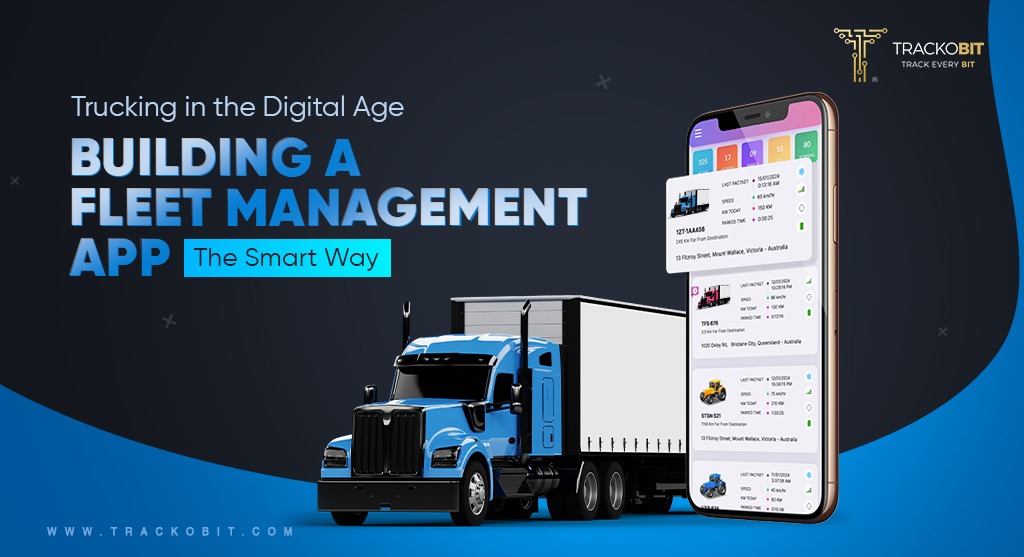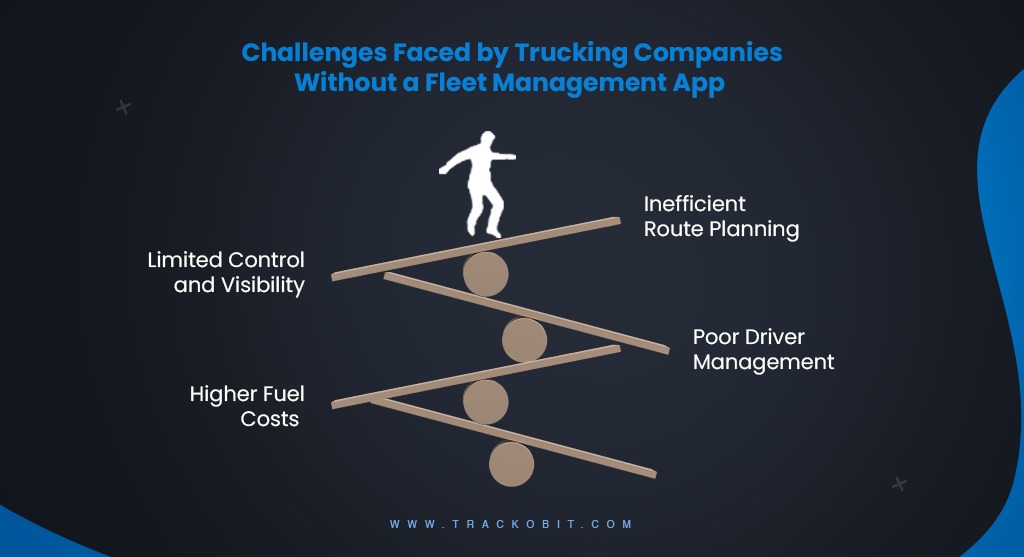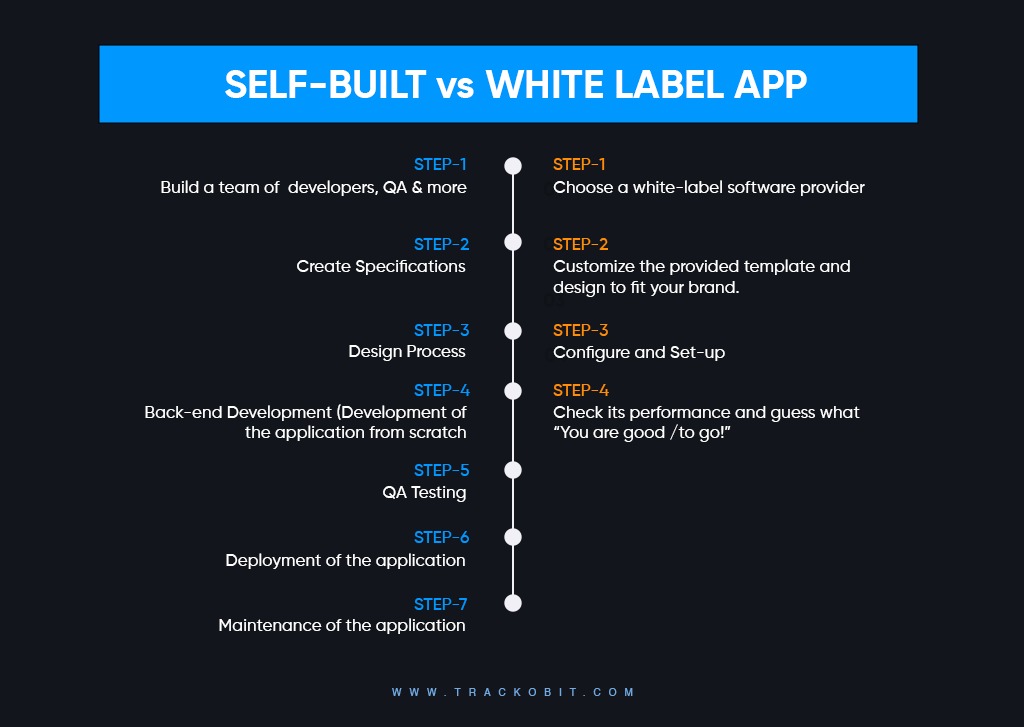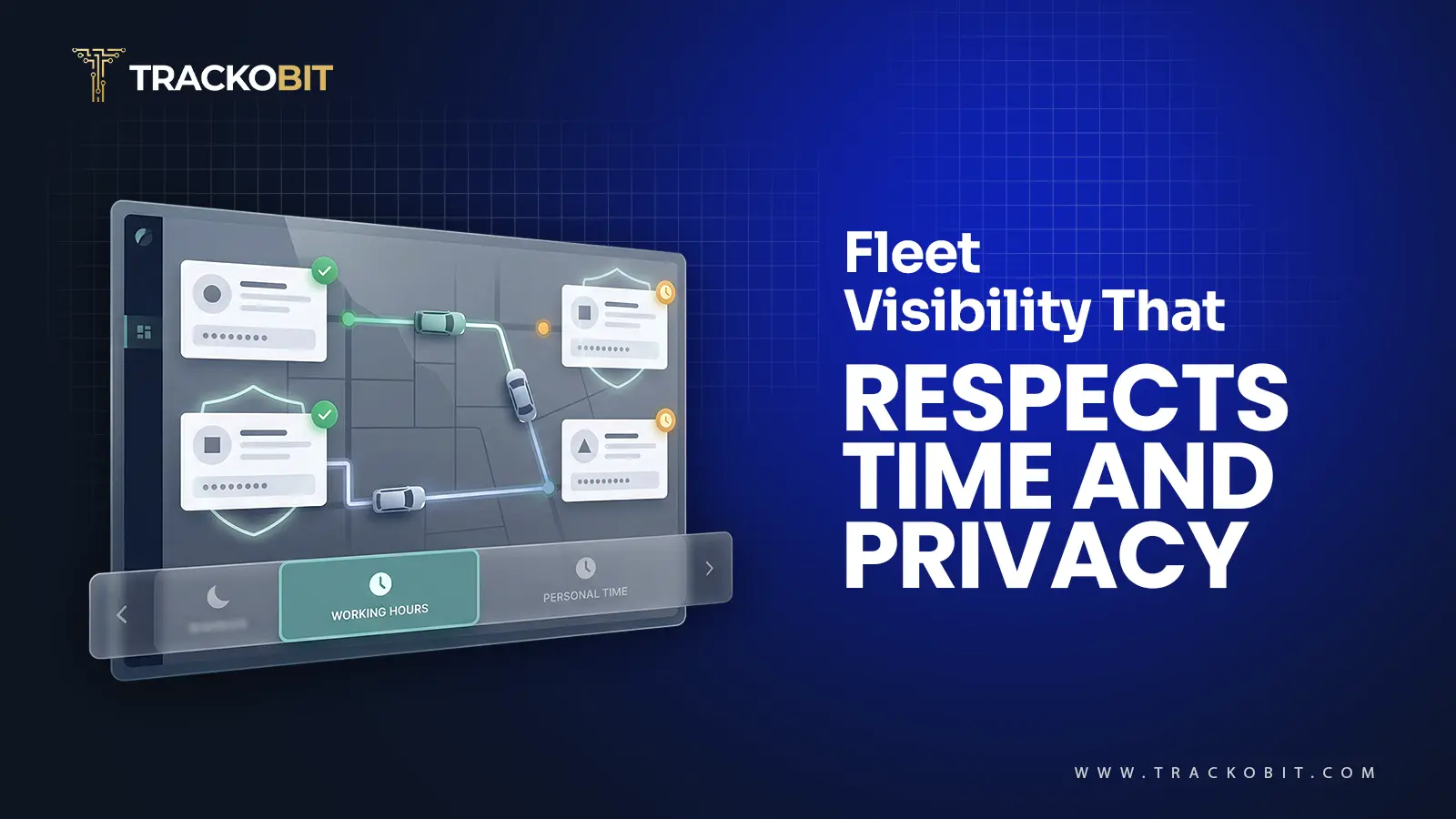-
TrackoBit
Manage commercial vehicles with the new-age Fleet Management Software
TrackoBit -
TrackoField
Streamline your scattered workforce with Field Force Management Software
TrackoField -
Features Resources
-
Blog
Carefully curated articles to update you on industrial trends. -
White Paper
Insightful papers and analysis on essential subject matters. -
Glossary
Explore an alphabetical list of relevant industry terms. -
What’s New
Get TrackoBit & TrackoField monthly updates here. -
Case Study
Explore the cases we solved with our diverse solutions. -
Comparisons
Compare platforms, features, and pricing to find your best fit.
-
About Us
Get to know TrackoBit: our team, ethos, values, and vision. -
Careers
Join the most dynamic cult of coders, creatives and changemakers. -
Tech Support
Learn about our technical support team and services in detail. -
Events
Check out the exhibitions where we left our marks and conquered. -
Contact Us
Connect with us and let us know how we can be of service.
How to Build a Fleet Management App For a Trucking Company?
- Author:Anvesha Pandey
- Read Time:7 min
- Published:
- Last Update: December 9, 2025
Table of Contents
Toggle
Consider ditching spreadsheets and improving fleet management with GPS tracking, fuel supervision, and seamless communication through fleet management apps. Create a user-friendly app prioritizing efficiency and simplicity. Let’s explore the process together.
Table of Contents
Toggle
The trucking industry has undergone significant advancements over time. In between all the technological developments and the increasing competition, efficiency is the king. However managing a fleet of vehicles, drivers, and routes can be a bit of a complex task.
A well-designed fleet management app can be your key to efficiency – streamlining operations, reducing costs, and monitoring trucks on the road.
This piece of writing will walk you through the steps of building a fleet management application and what challenges will come your way if you don’t have one.
Let’s get started, but before that let’s understand what are fleet management apps.
What is a Fleet Management App?
A fleet management mobile application is software that helps trucking companies manage, organize, and control their vehicles remotely. The core objective of such applications is to ensure smooth fleet operations on and off roads while enhancing the overall fleet economy.
Fleet management apps provide a range of tools and features that enable various functions like
- Real-time tracking of vehicles
- Efficient route planning
- Driver performance monitoring
- Maintenance scheduling
- Data Analytics
Now that you know what fleet management apps are. Together let’s uncover all the challenges your business may face if you don’t have one.
Challenges Faced by Trucking Companies Without a Fleet Management App

For decades now, transportation has been the lifeline of trade and commerce for economies across the globe. Today the industry runs on quick, competitive, and efficient mobility. It’s almost impossible to thrive without technology, automation, and software aid.
Here are the most encountered challenges by trucking companies that operate without a fleet management app –
-
Limited Control and Visibility
Manually tracking trucks through phone calls or outdated tracking systems is time-consuming and unreliable. This lack of real-time location data makes it difficult to monitor driver progress, respond to delays, or optimize routes. Also in addition, Without in-depth insights into driver behavior and vehicle health, managers struggle to identify and address potential problems before they escalate. (Here’s where ADAS and DMS technologies come into the game).
-
Inefficient Route Planning
Effective route planning is crucial for ensuring timely deliveries. In fact, without advanced tools like real-time visibility, tracking, communication, and more provided by these apps, companies often rely on manual or outdated methods for route planning. This can lead to inefficient routes, increased fuel costs, and longer travel times, ultimately affecting the company’s profits.
-
High Fuel Costs
According to the report of Entrepreneur, 34% of fleet managers believe truck fuel costs are very high. With the help of a fleet management app fleet owners or managers can monitor fuel consumption patterns, react to sudden drops in fuel levels, investigate unscheduled fuel refills, and spot fuel-guzzling driving practices.
-
Poor Driver Management or Miscommunication with Fleet Drivers
Managing a team of hundred drivers who are operating remotely can be a challenge. Driver management includes KYC, document verification, assigning trips, and monitoring driving behavior. Trucking companies may face difficulties in monitoring driver performance, ensuring compliance with regulations, and addressing issues such as fatigue or drowsiness. Moreover, poor driver management can lead to high turnover rates, increased accidents, and lower overall efficiency.
Want to stay ahead of your competition? Looking for advanced fleet management solutions?
How a Fleet Management App Eliminates All These Challenges
Real-Time Tracking and Optimized Routes
A fleet management app revolutionizes trucking operations by providing real-time tracking, optimizing route planning, and enhancing driver management. It ensures continuous visibility over the fleet, allowing for precise tracking of vehicle locations and timely deliveries.
The app utilizes advanced algorithms and plans to create efficient routes, reducing fuel costs and travel times.
Improved Driver Management
Comprehensive driver management features to improve performance monitoring and compliance, promoting safety and reducing turnover.
Preventative Maintenance
The app’s maintenance tracking capabilities ensure timely repairs and preventative upkeep, minimizing breakdowns and downtime. Companies can make informed decisions through detailed analytics and insights, optimizing overall performance.
Enhanced Customer Service
Improved tracking and communication enhance customer service by providing accurate delivery estimates and timely updates, leading to higher customer satisfaction and retention.
Now that you know all the challenges and how this one application caters to all these obstacles, you must surely be wondering how to build one.
The next section of this piece of writing covers how to build a fleet management app.
How to Build a Fleet Management App?

Building a fleet management app involves several key steps, from initial planning and design to development and deployment. Let’s get into the steps of creating a fleet management app.
Without elaborating on the technicalities involved in each step, we’ll give you a brief idea about how the development process flows. The below-mentioned steps will just be an overview of the entire process.
- Step 1- Defining the core objectives and requirements
- Step 2- Research the trends, features, and what is going on in the market.
- Step 3- Assemble a team of testers, and developers accordingly.
- Step 4- Create custom designs and user interfaces tailored to your brand.
- Step 5- Code the app from scratch or use development frameworks with the help of developers.
- Step 6- Conduct extensive testing for bugs, usability issues, and performance. This includes unit tests, integration tests, and user acceptance testing.
- Step 7- Set up servers, databases, and other infrastructure. Submit to app stores
- Step 8- Continuous monitoring, bug fixes, updates, and feature additions by your development team.
There are a few additional considerations that you should keep in mind while building a fleet management app like
- Prioritization of data security by implementing robust authentication, authorization, and encryption.
- Scalability to accommodate growth in the user base.
- Ensuring the app adheres to relevant regulations for the trucking industry (for instance ELD compliances, AIS 140 Guidelines, and more).
Now that you are aware of the basics of building a fleet management app, you must surely be wondering why all of this seems tiresome and costly. If you don’t want to start from scratch you can opt for a ready-to-deploy platform. That is easy to use and configure- Yes we are talking about White-label fleet management solutions. The table below showcases the difference between the two, have a look.
| Aspects | White Label App | Self-Built App |
| Definition | A pre-built application offered by a third-party provider is customizable for your brand. | Application built from scratch or customized extensively by your in-house team. |
| Development Time | Shorter, as the core functionality is already developed. | Longer, as the app is developed from the ground up. |
| Cost | Lower initial cost usually works on a subscription model i.e. per vehicle charges. | Higher initial cost, regular maintenance, and development costs. |
| Customization | Limited to the options provided by the white-label provider. | Extensive, and can be tailored to specific requirements. |
| Control | Limited control over core features and updates. | Full control over all aspects of the app. |
| Maintenance | Handled by the provider, included in the service fee. | Requires in-house resources for updates and bug fixes. |
| Time to Market | Faster, as the app is nearly market-ready. | Slower, due to the time needed for development and testing. |
| Technical Expertise Required | Minimal, mostly for regular operations and branding. | High, requires significant technical knowledge and expertise. |
| Scalability | Depends on the provider’s infrastructure and limits. | Can be designed to scale according to specific needs. |
| Innovation | Constrained by the provider’s roadmap. | Driven by the in-house team’s creativity and strategy. |
| Branding | Customizable within the limits of the provider’s framework. | Fully customizable to reflect the brand identity. |
Both self-built apps and white-label platforms have their own pros and cons, but yes if you have limited time and have less-investment bandwidth, you can opt for white-label fleet management solutions.
Essential Features of a Truck Fleet Management App
Creating an effective truck fleet management app requires incorporating a range of features to ensure comprehensive management, efficient operations, and regulatory compliance.
The below table showcases the categories and features your app should have.
| Solution | Essential Features |
| Real-Time Tracking | GPS tracking, real-time location updates, |
| Fleet Maintenance | Scheduled maintenance alerts, service history logs, diagnostic reporting |
| Driver Management | Driver profiles, hours of service (HOS) tracking, driver performance monitoring, Driver Application |
| Route Planning | Trip Planning, Estimated Time of Arrival, Proof of delivery, Route Deviation Alerts |
| Fuel Management | Fuel consumption tracking, fuel efficiency reports, fuel card integration, Refill and drainage alerts |
| Compliance & Reporting | Electronic Logging Device (ELD) compliance, IFTA reporting, DVIR, |
| Communication | In-app announcements, push notifications, emergency alerts |
| Document Management | Digital document storage, trip logs, expense receipts, 12-month history |
| Analytics & Reporting | Analytical dashboards, real-time analytics, performance metrics |
| Expense Management | Expense tracking, cost analysis, budget management |
Final Words
Now that we are towards the end of this piece of writing, we hope that you have some clarity about how a fleet management app is built. With changing times a well-designed app has been very important in enhancing operational efficiency, reducing costs, and more.
Building fleet management serves you with an array of benefits but surely it can be a time-consuming and long process, white- label software solutions are one of the best alternatives to apps built from scratch.
Want to save time and at the same time get a fleet management app customized according to you?
TrackoBit can be your partner in this!
FAQs
-
What is the cost of using a fleet management app?
The cost can vary widely depending on the features offered, the size of the fleet, and the provider. Some apps charge a monthly subscription fee per vehicle, while others may offer tiered pricing based on the number of vehicles and features required.
-
How do fleet management apps enhance safety?
Fleet management apps enhance safety by monitoring driver behavior (e.g., speeding, harsh braking), providing real-time alerts, scheduling regular maintenance to prevent breakdowns, and ensuring compliance with safety regulations.
-
What features should I look for in a fleet management app?
- Real-time GPS tracking - Maintenance scheduling and alerts - Fuel consumption tracking - Driver behavior monitoring - Route optimization - Compliance management - Reporting and analytics
Anvesha is a communication specialist at TrackoBit. With a strong background in media and communications, she adds much-needed balance and brevity to TrackoBit’s... Read More
Related Blogs
-

When Tracking Needs a Clock: Rethinking Fleet Visibility
Tithi Agarwal December 24, 2025Read on to understand why fleet tracking works better when it follows working hours. Because visibility should support operations, not…
-

What Makes TrackoBit’s Video Telematics Software Truly Next-Gen?
Shemanti Ghosh December 17, 2025TrackoBit’s video telematics software blends smart video intelligence with full server control. The result? Superior fleet reliability and safety.
-

Plug, Pair, Perform TrackoBit Introduces BLE Sensor Integration
Tithi Agarwal November 26, 2025TrackoBit’s BLE Sensor Integration enables wireless, real-time monitoring with faster installs and accurate insights. It improves fleet efficiency, visibility, and…
-

How to Use Driver Behavior Reports as a Sales Hook to Close Big Fleets
Tithi Agarwal October 16, 2025TrackoBit’s driver behavior reports empower fleet providers to win big contracts by showcasing safety, efficiency, and measurable ROI.

Subscribe for weekly tips to optimize your fleet’s potential!
Your inbox awaits a welcome email. Stay tuned for the latest blog updates & expert insights.
"While you're here, dive into some more reads or grab quick bites from our social platforms!"Stay Updated on tech, telematics and mobility. Don't miss out on the latest in the industry.
We use cookies to enhance and personalize your browsing experience. By continuing to use our website, you agree to our Privacy Policy.


































